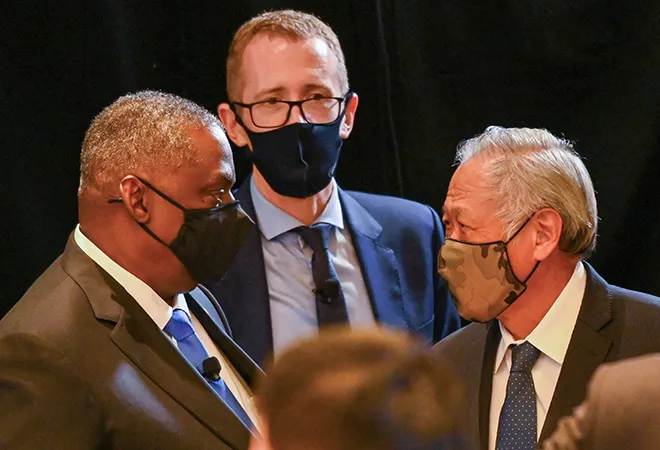
United States Secretary of Defense, Lloyd J. Austin III, is currently on a three-nation tour through Southeast Asia to Singapore, Vietnam, and the Philippines. This visit is likely to show the Biden administration’s commitment to demonstrate the importance given to Southeast Asia and ASEAN as an integral part of the Indo-Pacific architecture. Secretary of Defence Austin’s visit follows the visit by Deputy Secretary of State, Wendy Sherman, last month. According to a statement issued by Pentagon Press Secretary, John F Kirby, “This trip will underscore the enduring US commitment to the region, and our interest in upholding the rules-based international order in the region and promoting ASEAN centrality.” The same statement mentioned that in Vietnam, Austin is set to “meet key leaders to reiterate defense relationships and conduct bilateral meetings with senior officials”. While in Singapore, he is scheduled to deliver a lecture at the International Institute for Strategic Studies (IISS). In Manila, there will be talks and progress on a revamped and renegotiated Visiting Forces Agreement (VFA) that the US had signed with the Philippines in 1998.
Reinforcing ASEAN centrality
The first visit by one of the cabinet members of the Biden administration is significant as there is a growing perception in the minds of the Southeast Asian leaders that this region, in spite of being the hotspot for great power competition and Chinese belligerence, has been ignored and neglected by the previous and also by the current US administration. Moreover, there are still lingering doubts in Southeast Asia if the US is really serious and clearly defines ‘ASEAN centrality’ in its Indo-Pacific policy. This is especially for the push that is being given by the Biden administration to the Quadrilateral Alliance (QUAD), which many feel is a mechanism to wade away from the ‘ASEAN centrality’ and the predominance of ASEAN in regional architecture in the Indo-Pacific.
The Biden administration’s Southeast Asia strategy and its plans especially for economic and trade assignation and also military engagement has still not been disclosed
The Biden administration’s Southeast Asia strategy and its plans especially for economic and trade assignation and also military engagement has still not been disclosed. Considering how the Secretary of Defense, Austin, has himself emphasised, “You’ll hear me talk a lot about partnerships and the value of partnerships. My goal is to strengthen relationships”, it is pertinent for the US to use this visit as an opportunity to clearly lay out its policy and strategy for the Southeast Asian region. Getting ASEAN on board is very important for the US, especially given the US–China contestation and also for how this region is fast engaging and developing closer ties with China during the ongoing pandemic. After the Trump administration’s withdrawal from the Trans-Pacific Partnership (TPP) in 2017, though initially President Biden did underline his government’s aim to rejoin these initiatives, still no progress has happened on this front. This conveys the wrong message that the only focus for the US has been to point out Chinese encroachment activities in the South China Sea and undertaking frequent Freedom of Navigations Operations (FONOPs) in the disputed waters.
The statements issued from the Pentagon as mentioned above, clearly use the term ‘rules-based international order’, therefore, it is no guess that the Secretary of Defense “will call out aggressive Chinese behaviour in the South China Sea and stress the importance of keeping the wider region free and open.” Though with little effect on Beijing, the US has still consistently carried out the FONOPs in the South China Sea near Taiwan. Reinvigorating security ties with the three countries will be in the agenda. Aaron Jed Rabena, a research fellow at the Manila-based think tank Asia-Pacific Pathways to Progress and a member of the Philippine Council for Foreign Relations, noted that that Singapore and Vietnam have “an aligned political or defence agenda with the US”. Though the US does not have a security agreement with Singapore, the country still has an access agreement and a strong defence cooperation with the US. Singapore provides significant access for naval and air assets (for training) to the US. Vietnam’s relations with the US have come a long way. Vietnam is one of the rare ASEAN countries who has been vocal about the Chinese island reclamation and aggressiveness in the South China Sea and has also embraced the idea of external players having a stronger presence and role when it comes to Chinese actions, especially in the disputed South China Sea. Singapore and Vietnam, thus, are important political and security partners of the United States in this region.
The Philippines is one of the oldest security allies of the US. The VFA of 1998 allows the US troops as well as their vehicles and equipment to move in and out of Philippines’ territory. The Philippines’ President, Rodrigo Duterte, had warned of scrapping this agreement to show the Chinese his loyalty towards them and to mark his separation from the US. Though this decision has now been stalled, there are talks that during the visit, a new remodelled VFA with clauses more favourable to the Filipinos will be deliberated on. The focus on the part of the US will be to leave no stone unturned to get a final nod from Duterte about renewing this agreement. Furthermore, to show more solidarity to the Filipino side, the US State Department last month approved the potential sale of more than US $2.5 billion worth of military equipment to the Southeast Asian nation, including 10 Lockheed Martin F-16 fighter jets. This deal would be very substantial for the Philippines as there has been increasing presence of Chinese militia, coastguard, and naval vessels inside the Philippines’ exclusive economic zone (EEZ).
The Philippines is one of the oldest security allies of the US. The VFA of 1998 allows the US troops as well as their vehicles and equipment to move in and out of Philippines’ territory. The Philippines’ President, Rodrigo Duterte, had warned of scrapping this agreement to show the Chinese his loyalty towards them and to mark his separation from the US. Though this decision has now been stalled, there are talks that during the visit, a new remodelled VFA with clauses more favourable to the Filipinos will be deliberated on
Though the security and defence talks are important for the US as it countering China at the core of its national security policy for years and the Biden administration has tagged the competition with Beijing as the “biggest geo-political test of this century”, but at the same time, this visit should also stress and chart out a clear economic and trade policy for this region. Kurt Campbell, the National Security Council’s Indo-Pacific coordinator, said at an Asia Society event recently, “For an effective Asia strategy, for an effective Indo-Pacific approach, you must do more in Southeast Asia.”
Vaccine diplomacy in Southeast Asia
The ongoing pandemic has only fanned the economic and vaccine dependence of these countries, where the virus outbreak is again peaking in China. China is increasingly being viewed as indispensable for the region’s public health and economic recovery from COVID-19. Though there is concern about China’s growing power and assertiveness, but that is seen to take a backseat in light of the economic and trade benefits given by China. A vaccine diplomacy roadmap which has been discussed in the QUAD Leaders’ Summit—where it was decided that the vaccine diplomacy will reach Southeast Asia—has to be communicated to these countries. This will help facilitate the trust factor in the US and also in the US-backed cooperative mechanisms of the Indo-Pacific like the QUAD. The US can also, along with the QUAD partner countries, come up with a working group to look at an economic recovery plan for the Southeast Asian countries. It will not be difficult to garner support on this proposal as all the QUAD countries stress on ASEAN centrality in their Indo-Pacific strategies. This announcement can also be made by Secretary of Defense, Lloyd J. Austin in this visit.
Keeping in mind that the ASEAN countries are still divided in their approach when it comes to the US FONOPs and of the US presence in the face of China's militarisation of the waterway and its vast coastguard and fishing fleet, it would be more beneficial for the present US strategy for Southeast Asia to emphasise more on the economic and the health pillar (vaccine diplomacy)
Keeping in mind that the ASEAN countries are still divided in their approach when it comes to the US FONOPs and of the US presence in the face of China's militarisation of the waterway and its vast coastguard and fishing fleet, it would be more beneficial for the present US strategy for Southeast Asia to emphasise more on the economic and the health pillar (vaccine diplomacy). The most noteworthy will be if a timeline of the US’ willingness in rejoining pacts like the TPP are mentioned in the open. It has been rightly put by Abraham Denmark, a former Deputy Assistant Secretary of Defense for East Asia that “Washington was saying all the right things on competition with China but there were questions about how it could translate words into actions and investments.” In Southeast Asia, a careful balanced approach needs to be adopted whereby the China threat needs to be spoken of, and at the same time the message that US can be trusted both as a military and defence, as well as an economic partner needs to be brought out.
The views expressed above belong to the author(s). ORF research and analyses now available on Telegram! Click here to access our curated content — blogs, longforms and interviews.




 PREV
PREV


